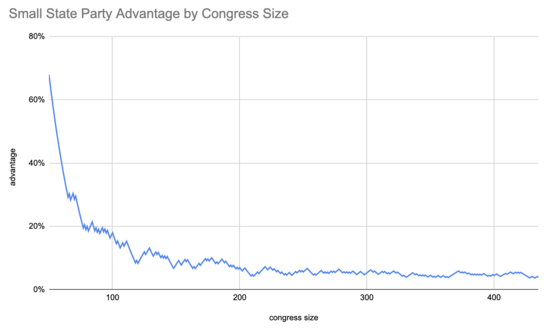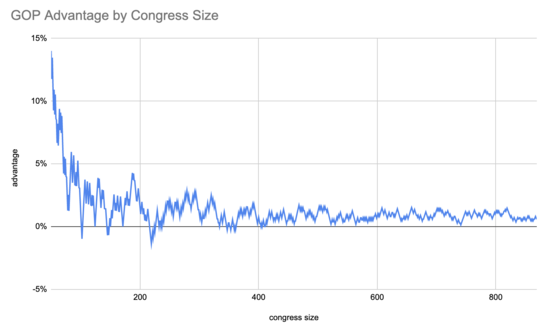Changing the size of Congress
post by jefftk (jkaufman) · 2020-10-22T20:50:05.879Z · LW · GW · 2 commentsImagine the Big State Party was popular in large states while the Small State Party was popular in small states. The Senate is per-state representation, which gives a large advantage to the Small State Party. The House is primarily proportional to population, except that every state constitutionally gets at least one Representative, so this still advantages the Small State Party a bit, but not by nearly as much. The President is elected by the Electoral College, and there's one vote for each Senator and Representative, plus three for DC. [1] This means that the balance of the Presidential election is somewhere between those of the Senate and House.
Now imagine that Small State is in a position where they control both houses on the presidency: can they turn a temporary advantage into a longer-term advantage by changing the size of the House?
First, the size of Congress is set by federal law so they are in a position to change it. The only constitutional restrictions or is that it needs to be proportional to population and that every state needs to get at least one representative. [2] If you shrink Congress until there are only 50 seats, one for every state, then it advantages the Small State Party by as much as the Senate does, while if you grow it substantially the minimum single Representative that each state gets starts to matter less.
The Small State party could get a 226 to 209 (+17/435, +4%) majority in Congress by getting a majority in the 42 smallest states. This requires about 26% of voters. With that level of support, they would easily take the Senate and Presidency. If they shrunk Congress to 50 seats, this would bring their House majority to 42 to 8 (+34/435, +68%). Now, this is probably too much of a change for the Supreme Court to accept within the meaning of "according to their respective Numbers", but even at 100 seats their majority would be 59 to 41, (+18/100, +36%):
While the Republican party is moderately more popular in smaller states, the current situation in the US is much less dramatic than the Small State / Big State divide above. We can label states as "Red" or "Blue" according to the Cook PVI [3] and see what this would look like with our actual political situation. This is throwing away a bunch of information, since I'm turning a nice range into a binary, but it makes the analysis much simpler. I'm also going to ignore the states that the PVI has as a neutral: NH, PA, WI.
With 435 seats PVI predicts +3 (+0.69%) for the Republicans. How does this change as the size of the House changes?
Overall, with our current political alignment, this doesn't look like a knob that people are likely to be trying to turn. You'd need to make the House so small that it would only dubiously filling its constitutional representational function before you would have much of an effect. Even if the parties were to realign, closely following a big state / small state axis, the necessary size change is still quite large.
[1] Technically, Washington DC gets as many electors as it would have
if it were a state, but no more than the smallest state. In all of
the scenarios were talking about here it comes out to be three.
[2] Technically, you also can't have more than one representative for every 30k people, but since the US population is over 300M, this would put the size of Congress at over 10k.
[3] I downloaded my numbers from Wikipedia, which says that the PVI numbers are based on the 2012 and 2016 presidential elections.
2 comments
Comments sorted by top scores.
comment by Czynski (JacobKopczynski) · 2020-10-23T16:15:33.693Z · LW(p) · GW(p)
I think the implications of enlarging the House are more interesting. Jump it up to a round 1000 and things look good for the Dems. Plus, what effect would that have on the Popular Vote Interstate Compact?
Replies from: jkaufman↑ comment by jefftk (jkaufman) · 2020-10-23T18:16:17.866Z · LW(p) · GW(p)
The main effect of increasing the size of the house is changing how things look for presidential elections, since there is one electoral vote for each house seat.
If you look at my "GOP Advantage by Congress Size" chart, you can see that the partisan lean of the house doesn't change much as you increase it.

